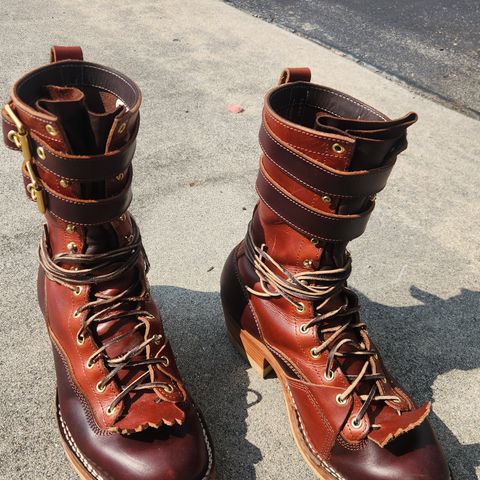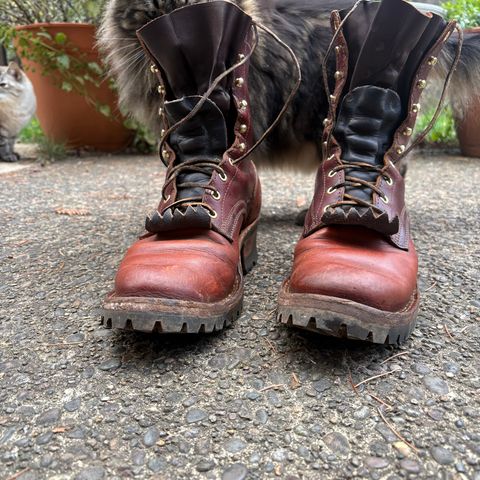About
Wickett & Craig Oiled Latigo is a vegetable-tanned leather produced by Wickett & Craig, one of only two remaining vegetable tanneries in the United States. The leather is distinguished by its hot-dipping process in a proprietary blend of oils, waxes, and tallows, resulting in a strong, pliable, and fully conditioned material with weather-resistant properties.
About
Wickett & Craig Oiled Latigo is a vegetable-tanned leather produced by Wickett & Craig, one of only two remaining vegetable tanneries in the United States. The leather is distinguished by its hot-dipping process in a proprietary blend of oils, waxes, and tallows, resulting in a strong, pliable, and fully conditioned material with weather-resistant properties.
Also known as Show Harness, Oiled Latigo exhibits a characteristic pull-up effect where the leather's color lightens when stretched or bent, particularly visible in lighter colors. This pull-up effect, combined with the leather's high oil content, creates a distinguished depth of color that develops further with age and use.
Manufacturing
Wickett & Craig produces Oiled Latigo using a six-week vegetable tanning process that employs tannins derived from Mimosa and Quebracho tree bark. The process includes four key stages: pre-tanning, tanning, dyeing with fat-liquoring and drying, and finishing.
After the vegetable tanning process, the leather undergoes hot-dipping in a special mix of oils, waxes, and tallows. This oil treatment step distinguishes Oiled Latigo from other latigo leathers, which typically undergo combination tanning (chrome tanning followed by vegetable tanning). Wickett & Craig's process uses pure vegetable tanning, resulting in a leather with different characteristics from traditional combination-tanned latigo.
The hot-dipping process saturates the leather fibers with oils and waxes, reinforcing the material to withstand elements while maintaining flexibility. The tannery produces Oiled Latigo in both firmer and softer tempers to accommodate different applications.
Characteristics
Oiled Latigo features a smooth texture with a slightly waxy feel due to its high concentration of oils and waxes. The leather is full-grain, preserving the natural surface of the hide, and displays water-repellent properties that make it suitable for outdoor applications.
The material is both strong and pliable, with flexibility that falls between pure vegetable-tanned leather (which is stiffer) and heavily stuffed pull-up leathers (which are softer). The high oil content gives the leather a greasy feel to the touch and creates the pull-up effect where areas under tension or flexing reveal lighter tones beneath the surface color.
One notable characteristic is the potential for oil leaching, where excess oils may migrate to the leather's surface, particularly in warmer conditions or when new. The leather's weather-resistant properties stem from its dense oil saturation, which allows it to repel water while maintaining breathability.
Specifications
Wickett & Craig offers Oiled Latigo in weights ranging from 2-3 oz. to 12-14 oz., accommodating applications from lightweight goods to heavy-duty straps and footwear. The leather is sold by side and back, with average sides measuring 24-27 square feet and average backs measuring 18-20 square feet.
Wickett & Craig produces Oiled Latigo in several colors, with published specifications available for Tan, Chestnut, Burgundy, Medium Brown, and Black. The leather is also available in Brown. Lighter colors show more pronounced pull-up effects and color variation compared to darker shades.
Pricing varies by grade, with Standard grade priced at $241-$274 per square foot, Utility grade at $225-$258 per square foot, and Special grade at $211-$241 per square foot. These prices reflect the labor-intensive vegetable tanning process and the proprietary oil treatment.
Applications
Oiled Latigo finds primary use in strap goods, including belts, harnesses, laces, and straps. The leather's combination of strength and flexibility makes it suitable for applications requiring durability under repeated flexing and tension.
In footwear manufacturing, Oiled Latigo is used for boots and shoes, particularly heritage and work boot styles where water resistance and durability are valued. The leather can be split to lighter weights for bag and case construction while maintaining its characteristic properties.
Traditional applications include equestrian equipment such as saddle strings, cinches, and braiding materials. The leather's weather resistance and oil content make it suitable for dog collars and leashes that may encounter outdoor conditions and moisture.
Care and maintenance
Oiled Latigo requires less frequent conditioning than non-oiled leathers due to its high initial oil content. Cleaning should be performed with warm water and mild saddle soap, avoiding harsh chemicals that could strip the leather's oils.
Conditioning is recommended every six to 12 months depending on use and environmental exposure. The leather should be stored indoors away from high humidity, which can cause mildew or accelerate oil breakdown. Additional beeswax can be applied to enhance water resistance for applications requiring extra protection.
The leather cannot be tooled or stamped due to its oil content, which prevents the crisp impressions needed for decorative leather work. Some tannages may exhibit color transfer to lighter materials when new, which diminishes as excess surface oils are absorbed through use.
References
"Oiled Latigo". Wickett-Craig. Retrieved October 9, 2025.
"Wickett and Craig - One Of America's Finest Tanneries". DaLuca Straps. Retrieved October 9, 2025.
What is Latigo Leather? Complete Guide. Eiken Shop. Retrieved October 9, 2025.
"Latigo Leather - When to Use This Flexible, Durable Leather". Liberty Leather Goods. Retrieved October 9, 2025.






















































